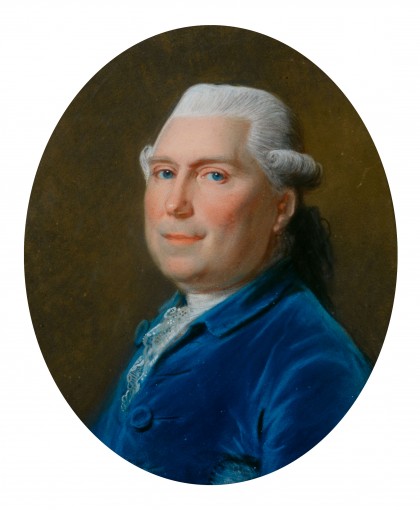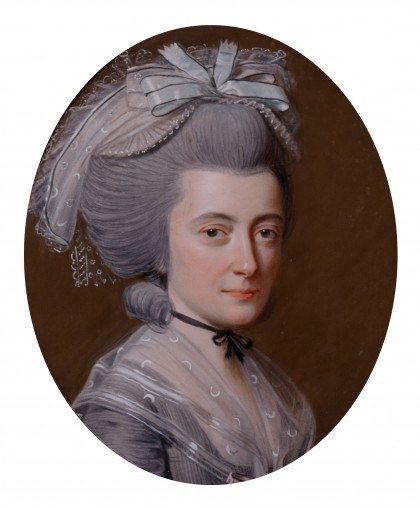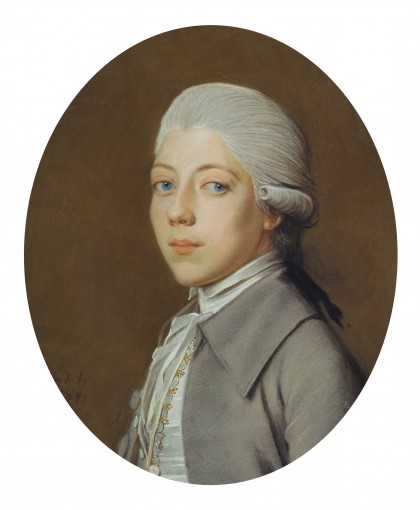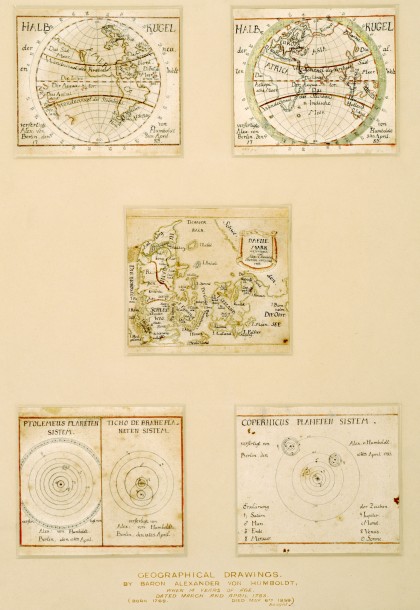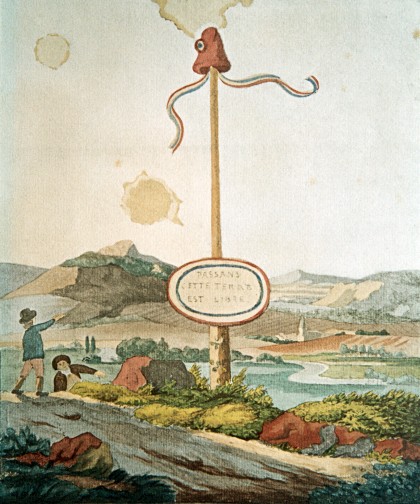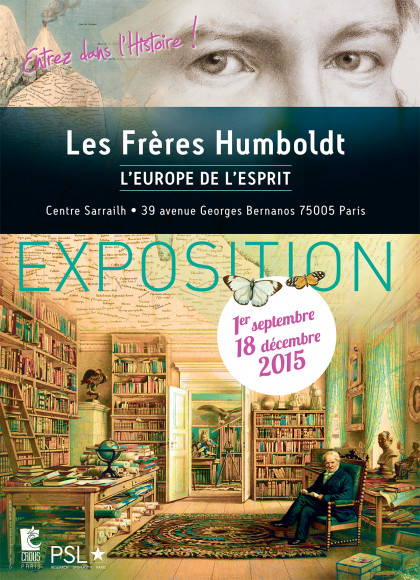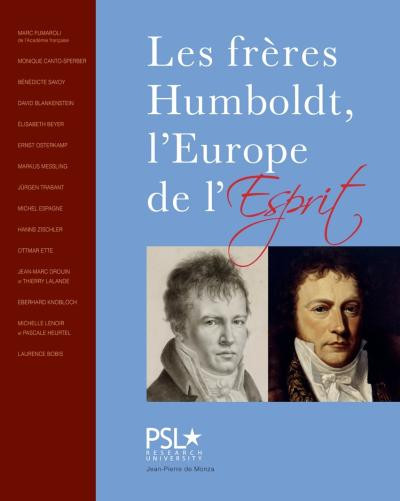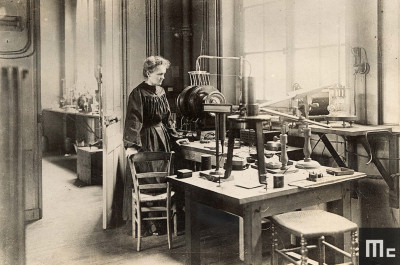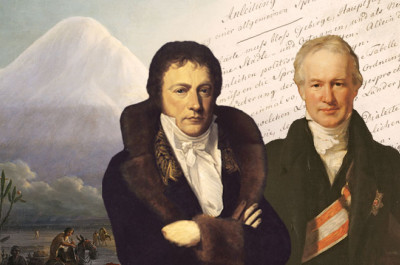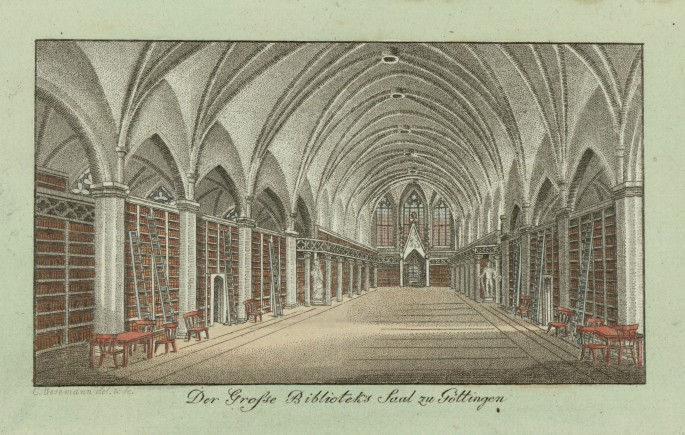
Alexander and Wilhelm von Humboldt
The von Humboldt family
Wilhelm was born in Potsdam on June 22nd 1767 and Alexander two years later, in Berlin, on September 14th 1769, into an aristocratic Prussian family. Their father, Alexander Georg von Humboldt, Major General in the Prussian army, was Chamberlain to Friedrich II. Their mother, Marie-Elisabeth Colomb, was a Huguenot of French descent; her family had emigrated to Prussia in the 17th century.
Wilhelm and Alexander spent their childhood between Berlin and the family estate, Tegel Castle, ten kilometers north of the city. There they were tutored by some of the brightest intellectuals of the Berlin Enlightenment scene, preparing them to take their place as members of the Prussian intellectual elite.
Following their father's death in 1779, their mother, Marie-Elisabeth, carried on the brothers' ambitious and liberal education, in keeping with her husband's wishes.
Education
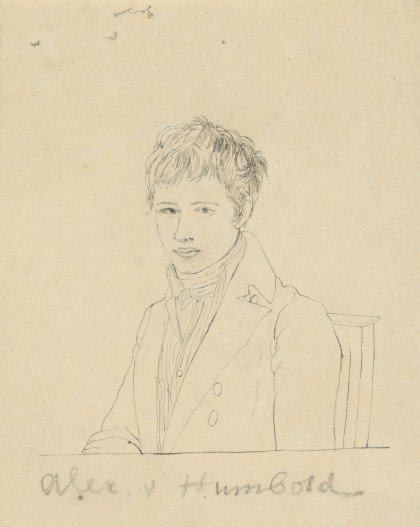
François Gérard, c. 1805, Encre noire, 12 x 10 cm, Universitätsbibliothek Leipzig, PSL, Inv.-Nr. 23/232. © Universitätsbibliothek Leipzig
Tutors
The choice of tutors played a determining role in the Humboldt brothers' education. Wilhelm et Alexander first received tuition from Joachim Heinrich Campe, a follower of Rousseau and one of the first authors to publish books specifically for young people. Using works such as Robinson de Jüngere (The Young Robinson), Campe introduced the brothers to the subject of the New World and the tales of navigators, imbuing them with a fascination for exotic countries and cultures.
In 1777, Gottlob Johann Christian Kunth, a 20 year-old educator, became their principal tutor. He taught them mathematics, literature, German, Latin, Greek, French, history, and geography. He continued their tuition until they left for university in 1787 and maintained life-long ties to the Humboldt family. He is buried alongside the family at Tegel Castle.
Educated together in the spirit of classical humanism and the Enlightenment, the Humboldt brothers developed very different characters and centers of interest.
Even as a child, Alexander, an extrovert, showed a marked interest for natural history, observing, describing and classifying plants, rocks and all sorts of natural phenomena.
Wilhelm, on the other hand, was an introvert with a robust constitution and a facility for learning that destined him for the upper echelons of public service.
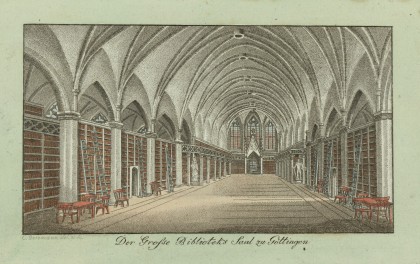
Christian Andreas Besemann, 1816, 8 x 10 cm, Göttingen, Niedersächsische Staats-und Universitätsbibliothek.
© Universitätsbibliothek Göttingen
In late 1787, Wilhelm and Alexander began studying law at the University of Frankfurt an der Oder, accompanied by their tutor Kunth. But it is at the University of Göttingen, where Wilhelm enrolled in the summer of 1788 followed by Alexander one year later, that the brothers truly began to develop their personal intellectual focuses and a shared appetite for encyclopedic knowledge. Together, they studied experimental physics, philology, archeology, history and economics. Alexander also developed a passion for Johann Friedrich Blumenbach's lectures on anatomy, comparative zoology and geology.
Freiberg Mining Academy
In 1791, Alexander enrolled at the Bergakademie Freiberg (Freiberg Mining Academy), famous throughout Europe for a curriculum combining theory and practice. At Freiberg, Alexander spent his mornings in the mine and his afternoons in the classroom. It took him a mere eight months to complete the standard three-year course of studies. Setting aside his desire to travel, Alexander began what was to be a stellar career as assessor for Prussia's Department of Mines and Ironworks. While working there, he pursued his research in physics and subterranean biology. Particularly concerned by working conditions in the mines, he invented two tools that would contribute to the miners' chances of survival in case of emergency: a miner's lamp that could function without oxygen and a breathing apparatus.
Cultural life
Berlin Society
From 1785 on, the Humboldt brothers frequented the home and literary salon of Markus Herz, a physician and student of Kant, and his wife Henrietta. Through the Herz, Wilhelm and Alexander became members of the Berlin intelligentsia, a liberal and composite circle that unreservedly welcomed both men and women as well as intellectuals of all social backgrounds and all religions. It is in precisely this circle that Wilhelm was to meet his future wife Caroline.
The major socio-cultural transformations that swept the Prussian capital in the 1780's provided the conditions for self-reflection and debate about the nature of the Enlightenment. Emmanuel Kant and Moses Mendelssohn, the most respected German philosophers of their time, reflected on the nature and practices of Enlightenment and their influence on Human Destiny. Although neither of the Humboldt brothers knew the two philosophers personally, both cite them as having had a major influence on their own intellectual development.
Weimar and Jena
On June 29th 1791, Wilhelm von Humboldt married Caroline von Dacheröden in Erfurt. In 1794, the couple moved to Jena where Caroline introduced her husband to the Weimar and Jena intellectual circles. They met Johann Gottfried Herder and Johann Gottlieb Fichte and formed a lasting friendship with Friedrich Schiller, Goethe and the archeologist Friedrich August Wolf. Wilhelm von Humboldt participated actively in the Weimar and Jena philosophical and literary community's reflection, research and philosophical debates, with a special focus on defining a new aesthetics. He collaborated with Schiller and published two contributions on the subject in Schiller's journal Die Horen. Wilhelm's research on aesthetics had a profound influence on his views in general and his perspective on classical Antiquity in particular.
First Paris experience
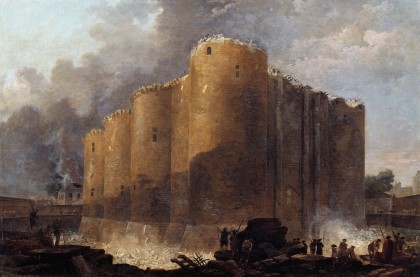
Hubert Robert, 1789, 77 x 114 cm, Paris, musée Carnavalet. © Photo Josse / Leemage
The French Revolution
It was the explorer Georg Forster, encountered in Göttingen, who first introduced the Humboldt brothers to the politics of the French Revolution. Forster was Jacobin from the start; he founded the Republic of Mainz in 1792 after travelling the world with James Cook from 1772 to 1775. Known for his harsh criticism of despotism, he introduced Wilhelm to the ideas of the French Revolution.
Travelling to Paris for the first time with his tutor, Joachim Heinrich Campe, the 22 year-old Wilhelm arrived shortly after the storming of the Bastille. During the weeks spent in a French capital rife with revolutionary fervor, Wilhelm wrote the following observations:
As for Alexander, he visited Paris for the first time a year after his brother, in July 1790, following a trip with one and the same Georg Forster to Brabant and Flanders, both in the midst of revolt. In Paris, Alexander participated in preparations for the Fête de la Fédération (Feast of the Federation).
These trips to Paris were to shape the brothers' political and social ideas as well as their conception of the Nation and State.
Related events and resources
Exhibition at the CROUS de Paris
In 2014, Paris Sciences et Lettres produced its first exhibition, in close collaboration with researchers and prestigious institutions in France and in Germany. One year later, PSL and the CROUS de Paris joined forces to bring the exhibit to the heart of our academic community. At the Centre Sarrailh, students, faculty and staff could visit and revisit the exhibit, discover and draw inspiration from Alexander and Wilhelm von Humboldt and their extraordinary lives of travel, scientific discovery, innovation and accomplishment.
Dates: September 1st through December 18th 2015 Entry: Free of charge
Opening hours: Open to the public Monday tnrough Friday from 9:30 am to 4::30 pm.
Place: Centre Sarraih, 39 avenue Georges Bernanos, 75005 Paris
Catalogue of the exhibition
Les frères Humboldt. L'Europe de l'esprit, publisher: De Monza, 2014, 200 pages.
This catalogue accompanies the exhibition "Les frères Humboldt, L'Europe de l'Esprit" (The Humboldt brothers – The Spirit of Europe) produced by Paris Sciences & Lettres (PSL) and shown at the Observatoire de Paris from May 15th through June 30th 2014. The catalogue is divided into 5 sections, mirroring the exhibition's main themes: "Matrix: family background and contemporary interest in classical Antiquity", "Res Publica: Revolution. Regeneration", "Europe and the World: Otherness as an intellectual horizon", "Morphologies: of parts and the whole", and "Sharing knowledge". The catalogue is far more than a simple visual reminder of the exhibition (maps, objects, letters and publications), it is also a theoretical work comprising 10 essays written by eminent scholars.
Throughout the catalogue, insets by Laurence Bobis, Director of the Observatoire de Paris library, provide the reader with additional bibliographic, political and scientific information. The catalogue is designed for the general public, for visitors to the exhibition and for informed or academic readers. Its intention is to prolong the exhibition experience and emphasize the intellectual, philosophical and ethical values to which the Humboldt brothers devoted their lives. These brilliant polymath intellectuals, one focused on science, the other on the humanities, were driven by a deep and unwavering humanism and a shared vision for a unified Europe, founded on progress and knowledge.
The catalogue can be found on most on-line book platforms as well as at the l'Ecume des pages bookshop (174 Boulevard Saint-Germain, 75006 Paris).
About the exhibition
This virtual exhibition follows on the physical exhibition The Humboldt brothers – The Spirit of Europe held at the Observatoire de Paris from May 15th through July 11th 2014. A smaller physical version of the exhibition was shown in 2015 at the Centre Sarrailh, 39 avenue Georges Bernanos, thanks to a PSL /CROUS de Paris partnership.
The Humboldt brothers have become a symbol of the intellectual, philosophical and ethical values that bind France and the Germanic World despite their tumultuous political history: a fascination for classical Antiquity and a deep attachment to rationalism and universalism. The exhibition is a first for PSL - Paris Sciences et Lettres Research University, and the first French exhibition devoted solely to the Humboldt brothers. Our goal: to open a window onto the extraordinary intellectual effervescence of a era when anything was possible, by presentation the life and work of two stellar intellectuals, their insatiable curiosity for the world around them, their commitment to advancing and sharing knowledge and science, and their incredible talent for innovation.
The Humboldt brothers influenced generations of intellectuals and scholars the world over. PSL shares their fundamental belief in the unity of the Sciences and the Arts and the academic ideals they defended: a university founded on the principles of scientific excellence, where academics and research are intimately linked, and where all disciplines coexist without boundaries, from astrophysics to the visual and performing arts, from mathematics to the humanities.
Click here to download the press kit [1502.0Ko]
Physical exhibition curated by
Bénédicte Savoy, Professor of Art history, Berlin
David Blankenstein, graduate in art history and museum studies
Produced by
Paris Sciences et Lettres Research University (PSL), in partnership with Labex TransferS.
Scientific Committee
Under the chairmanship of Marc Fumaroli, member of the Académie française.
- Elisabeth Beyer - cultural attaché in charge of books at the French Embassy in Germany
- Laurence Bobis - Director of the Observatoire de Paris library
- Monique Canto-Sperber - (then) President, Paris Sciences et Lettres Research University
- Barbara Cassin - Director of Research, CNRS
- Michel Espagne - Director, Labex TransferS
- Ottmar Ette, Professor - University of Potsdam
- Christine von Heinz – owner of Tegel Castle and the castle archives
- Ulrich von Heinz - owner of Tegel Castle and the castle archives
- Eberhard Knobloch – Professor Emeritus, Technische Universität Berlin (Technical University of Berlin)
- Michelle Lenoir, Director of the Muséum national d'histoire naturelle main library
- Central library - Henri Loyrette, Conseiller d'Etat, France
- Daniel Marchesseau, conservateur général honoraire du patrimoine (honorary Conservator General of Culture)
- Hermann Parzinger, President of the Stiftung Preußischer Kulturbesitz (Prussian cultural Foundation)
- Jürgen Trabant, Professor Emeritus, Die Freie Universität Berlin (Free University Of Berlin)
Acknowlegements
Marc Fumaroli and Monique Canto-Sperber would like to thank:
The Honorables Susanne Wasum-Rainer, German Ambassador to France
Mr. Louis Gallois and Mr. Louis Schweitzer, Commissaires généraux à l'investissement (Frenchgovernment investment comissioners)
Mr. Claude Catala, President, the Observatoire de Paris
The founding members of the Paris-Sciences et Lettres Foundation, members of Labex TransferS and and its Director Michel Espagne
La République des Savoirs and its director Antoine Compagnon
As well as:
Emmanuel Suard and Hubert Guicharrousse (Berlin, French Embassy in GermanyAllemagne), Hinrich Sieveking (Munich, Winterstein collection ), Heinrich Schulze Altcappenberg (Berlin, Kupferstichkabinett SMB-PK), Isabelle le Masne de Chermont (Paris, BNF), Caroline Noyes and Gabriel Carlier (Paris, MNHN), Manfred Gräfe and Cornelia Gentzen (Berlin, Stiftung Stadtmuseum, Humboldt-Sammlung Hein and Hausarchiv), Hans-Dieter Nägelke and Claudia Zachariae (Berlin, Technische Universität, Architekturmuseum), Stéphanie Baumewerd, Annick Trellu and Philippa Sissis (Berlin, Technische Universität, Art History Institute), Elisabeth Michel (Berlin), Sandrine Maufroy (Paris, Université Paris 4-Sorbonne), Emilie Oléron Evans (London, Queen Mary, University of London), Marie-Ange Maillet (Paris, Université Paris 8-Saint-Denis), Vincent Platini (Berlin, Freie Universität), Leah Stearns (Monticello, Thomas Jefferson Foundation at Monticello).
Project coordinators
Hélène Chaudoreille
Véronique Prouvost
Virtual exhibition production
Nathalie Figueroa
Assisted by
Annael Le Poullennec and the team at the PSL Resource and Knowledge department
Dimitri Le Meur, ENS.
Translation
Robin Silver-Delouvrier (French to English)
Voice recordings (readings)
Thomas Claret, Alice Billon, Anne Buers
Image credits
- Gottlieb Schick, Wilhelm von Humboldt, 1808, oil on canvas, 86 x 66 cm, © Berlin, Deutsches Historisches Museum
- Henry William Pickersgill, Alexander von Humboldt, 1831, oil on canvas, 142,2 x 109,2 cm © Bridgeman Art Library
- Johan Weitsch, Humboldt et Bonpland au pied du Chimborazo en Equateur (Humboldt and Bonpland at the foot of mount Chimborozo...), 1806, oil on canvas, 163 x 226 cm © BPK, Berlin, Dist. RMN-Grand Palais / Hermann Buresch
- Wilhelm von Humboldt, Anleitung zur Entwerfung einer allgemeinen Sprachkarte [Instructions for making a general map of spoken languages], annex to a letter from Wilhelm von Humboldt to Goethe dated November 15th 1812, ink on paper, © Weimar, Klassik Stiftung Weimar, Goethe und Schiller-Archiv

